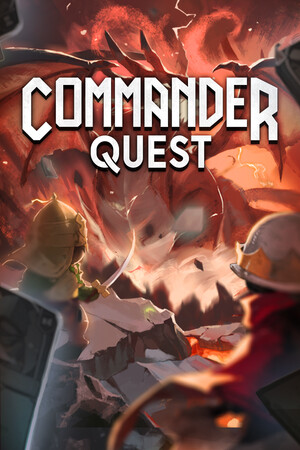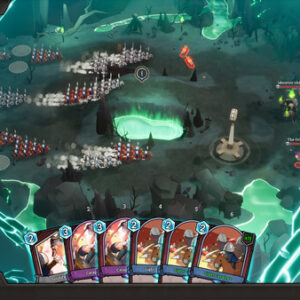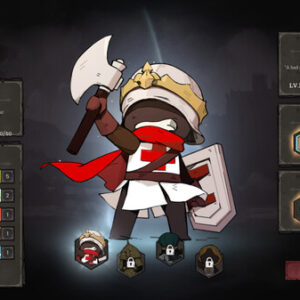Commander Quest Free Download Direct Steam-Cracked
The Role of Heroes: Building a Legendary Commander
In Commander Quest, heroes are not just powerful figures on the battlefield but also key elements in shaping your strategy and deck. Each hero brings their unique abilities, story, and synergies to the game, and understanding how to utilize their strengths is crucial for success.
Hero Classes and Abilities
Heroes are divided into several classes, each with its unique abilities and playstyle. Some classes specialize in offense, while others focus on defense, healing, or support. Each hero also has a signature ability that can turn the tide of battle when used effectively.
The Warrior Class: Masters of the Frontlines
Warrior-class heroes, like Ragnar Ironfist, are known for their prowess in close combat. These commanders often have high health and armor, allowing them to serve as the backbone of any army. They are often equipped with abilities that enhance melee damage, provide crowd control, or boost the durability of tanks.
Warrior heroes can also buff nearby allies with defensive abilities or improve unit attack speed, making them perfect leaders for aggressive strategies. They thrive in direct confrontations, especially when supported by a solid foundation of damage-dealing units and tanks.
The Mage Class: Masters of Elemental Power
Mage-class heroes, such as Elda the Flameweaver, wield the forces of the elements to decimate their enemies from a distance. Whether controlling fire, ice, lightning, or earth, mage heroes are capable of devastating area-of-effect (AoE) spells that can obliterate multiple units in one go. However, they tend to be fragile and require protection from other units to avoid being overwhelmed.
Their strategic importance lies in the ability to soften enemy forces before they engage with your main army, as well as in their synergies with magic-based units and summons. In addition, many mage heroes have crowd-control abilities that can freeze, stun, or slow enemy units, disrupting their plans and allowing your forces to maintain control of the battlefield.
The Rogue Class: Masters of Stealth and Precision
Rogue-class heroes, like Syla the Shadowed One, are adept at operating in the shadows, using their stealth and agility to outmaneuver the enemy. These heroes typically have the ability to teleport, infiltrate, and strike with deadly precision. They often come with high mobility and damage output, but they tend to be fragile and require careful positioning to avoid getting overwhelmed.
Rogue heroes excel in hit-and-run tactics, ambushing, and dealing critical damage. Their abilities often revolve around disrupting enemy formations and picking off high-value targets. These heroes thrive in situations where they can seize the initiative and strike before the enemy can respond.
The Healer Class: Masters of Restoration
Healer-class heroes, such as Lyra the Lifebringer, are indispensable to any well-rounded army. These heroes specialize in healing, buffing, and removing debuffs from their allies. They have the ability to revive fallen units, remove status effects, and restore health over time.
While healers are not typically offensive powerhouses, their ability to keep your forces alive in extended battles is crucial. Many healer heroes come with aura abilities that provide global healing, as well as defensive buffs that increase your units’ resistance to damage. Healers work best when paired with high-health units, tanks, and support heroes.
Hero Customization and Progression
As you continue to progress through Commander Quest, your heroes will evolve. This progression involves upgrading their stats, abilities, and equipment. By gathering experience and unlocking new skills, you can further customize your hero to suit your playstyle and strategy.
-
Leveling Up: Heroes gain experience from battles, which can be used to level up and unlock new abilities. Each hero has a unique skill tree that allows you to specialize in certain areas—whether it’s improving your damage output, defense, healing, or crowd control.
-
Artifact and Gear Customization: As you defeat powerful enemies, you’ll gain access to artifacts and gear that enhance your hero’s abilities. These items can increase your hero’s damage, health, or mana regeneration, and can often unlock special abilities that give your hero an edge in battle.
Strategic Combat Mechanics: Maximizing Unit Synergies
Understanding the intricacies of combat mechanics is key to mastering Commander Quest. The game blends deck-building and real-time strategy (RTS) elements, making each battle feel dynamic and rewarding. Players must think not only in terms of individual card choices but also how to maximize the synergies between units, heroes, and abilities.
The Role of Unit Synergies
Unit synergies are at the heart of Commander Quest’s gameplay. Each unit has inherent affinities and synergies with other units, which can enhance their effectiveness in battle. For example:
-
Healing Synergies: Units with the healing affinity can benefit from the presence of healers or other support units, increasing their survivability and allowing them to last longer in battle.
-
Offensive Synergies: Certain damage-dealing units might work best when paired with others that boost attack speed, damage output, or critical hit chances. Ranged units can also benefit from tank units that block incoming attacks, allowing them to focus on damage without interruption.
-
Elemental Synergies: Some units have elemental affinities, such as fire, water, earth, and air, that can enhance their abilities when paired with other units of the same element. For example, fire-based units can deal extra damage to water-based units or buff each other when deployed together.
Advanced Combat Tactics
In addition to unit synergies, positioning and timing are essential components of battle. Here are some advanced strategies to consider when engaging in combat:
Flanking and Terrain Control
Flanking is an advanced tactic that involves positioning your units around the enemy to hit them from multiple angles. By attacking from the side or rear, you can often bypass the enemy’s defense and deal significant damage. Additionally, high ground provides line-of-sight advantages for ranged units, making it an essential factor in combat.
Controlling terrain is also crucial. Certain areas of the battlefield might offer defensive bonuses, regeneration zones, or environmental hazards that can turn the tide of battle. For example, lava pits or swamps may slow down enemy units, giving you the advantage of time.
Utilizing Unit Roles and Effects
Each unit in Commander Quest has a specific role—whether it’s a tank, damage dealer, support unit, or healer. Understanding these roles and how to combine them effectively is crucial for success. Tanks should be placed on the frontlines to absorb damage, while damage-dealing units like archers or mages should be kept in the back, out of harm’s way. Healers and support units should be strategically positioned to provide buffs, debuffs, or crowd control.
Moreover, many units have unique effects or abilities that can alter the battlefield. For example, certain summon units can block enemy movement, while others might debuff enemies with poison, burn, or stun effects. Managing these effects is key to maintaining control over the battlefield.
Card and Unit Management
In Commander Quest, the balance between card play and unit management is delicate. Players must plan several turns ahead, carefully managing their cards and resources to ensure they can summon powerful units at the right moments. Efficient card management is key to maintaining a steady flow of reinforcements, while careful unit placement ensures that your forces stay organized and ready for combat.
The Endgame: Challenges and Boss Fights
As you progress through Commander Quest, you’ll encounter more challenging scenarios and boss fights that will test your strategic skills. These battles are designed to push your deck-building abilities to their limits and force you to think creatively.
Endgame Bosses
Endgame bosses are often massive and require careful coordination and timing to defeat. These bosses come with unique abilities, summon minions, and often require you to adjust your standard tactics. For example, some bosses might have immunity to certain debuffs, meaning you’ll need to rely on other forms of damage or strategy to take them down.
These encounters can be particularly challenging because of the multi-phase mechanics that can dramatically change the flow of battle. Bosses might summon waves of enemies, change the terrain, or apply debuffs to your units, forcing you to adapt to new conditions at a moment’s notice.
SYSTEM REQUIREMENTS
- OS: Windows 10/11
- Processor: i5-4670K @ 3.4Ghz or similar
- Memory: 8 GB RAM
- Graphics: GeForce 970 or better
- DirectX: Version 12
- Storage: 5000 MB available space
Game Insights
- Genre: Indie, Simulation, Strategy
- Developer: Flyway Games, Inc.
- Platform: PC
- Game Size: 2.9 GB
- Released By: TENOKE
- Version: v1.0.32.722 | Full Version
- Full PC Games


